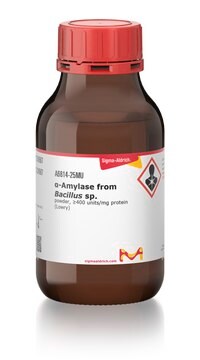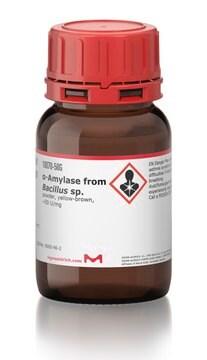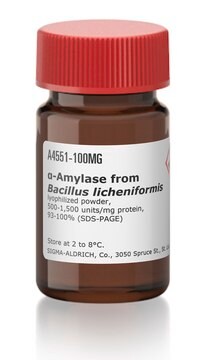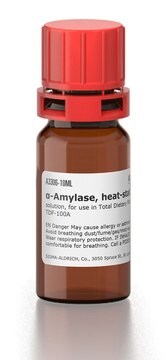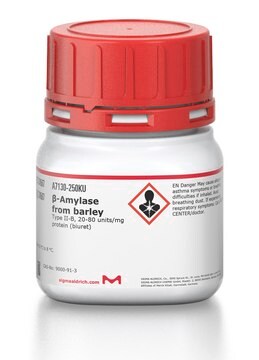A6380
α-Amylase from Bacillus sp.
Type II-A, lyophilized powder, ≥1,500 units/mg protein (biuret)
Synonyme(s) :
Alpha-Amylase, Glycogenase, 1,4-α-D-Glucan-glucanohydrolase
About This Item
Produits recommandés
Source biologique
bacterial (Bacillus amyloliquefaciens)
Niveau de qualité
Type
Type II-A
Pureté
≥30%
Forme
lyophilized powder
Activité spécifique
≥1,500 units/mg protein (biuret)
Poids mol.
50-55 kDa by SDS-PAGE
Technique(s)
SDS-PAGE: suitable
Solubilité
H2O: soluble 0.1 mg/mL, clear, colorless
Adéquation
suitable for hydrolysis, synthesis of oligosaccharides and polysaccharides, and sugar modification
Application(s)
life science and biopharma
Température de stockage
−20°C
Vous recherchez des produits similaires ? Visite Guide de comparaison des produits
Catégories apparentées
Description générale
Application
- as a component of salivary fluid to perform artificial mastication; in luminal gastrointestinal digestion experiment
- as a standard in sodium dodecyl sulfate-polyacrylamide gel electrophoresis (SDS-PAGE) to determine the concentration of α-Amylase
- to de-starch the alcohol insoluble residue (AIR) for non-cellulosic neutral monosaccharide analysis
Actions biochimiques/physiologiques
Caractéristiques et avantages
- α-Amylase from Bacillus licheniformis NCIB 6346 retains over 98% of its activity after 60 minutes at pH 6.2 and 85°C.
- Other α-Amylase maintain 100% of their activity after storage for 1 hour at 91°C.
Définition de l'unité
Notes préparatoires
Autres remarques
Substrat
Mention d'avertissement
Danger
Mentions de danger
Conseils de prudence
Classification des risques
Resp. Sens. 1
Code de la classe de stockage
11 - Combustible Solids
Classe de danger pour l'eau (WGK)
WGK 1
Point d'éclair (°F)
Not applicable
Point d'éclair (°C)
Not applicable
Équipement de protection individuelle
dust mask type N95 (US), Eyeshields, Faceshields, Gloves
Certificats d'analyse (COA)
Recherchez un Certificats d'analyse (COA) en saisissant le numéro de lot du produit. Les numéros de lot figurent sur l'étiquette du produit après les mots "Lot" ou "Batch".
Déjà en possession de ce produit ?
Retrouvez la documentation relative aux produits que vous avez récemment achetés dans la Bibliothèque de documents.
Les clients ont également consulté
Notre équipe de scientifiques dispose d'une expérience dans tous les secteurs de la recherche, notamment en sciences de la vie, science des matériaux, synthèse chimique, chromatographie, analyse et dans de nombreux autres domaines..
Contacter notre Service technique